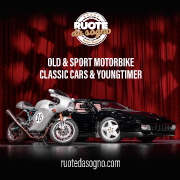Chassis No. 10563 Engine No. 1892 Transmission No. 584 I/R Introduced at the 1964 Paris Salon as successor to the elegant 250 GT Berlinetta Lusso, the 275 GTB showcased a combination of technologies that would define modern Ferrari GT design for decades: independent rear suspension, rear-mounted transaxle configuration, and aerodynamic Pininfarina coachwork. The new berlinetta achieved immediate acclaim both on road and track, with competition variants taking part in the Targa Florio, Nürburgring 1000 Kms, and the 24 Hours of Le Mans where the 275 GTB Competizione of Écurie Francorchamps claimed 3rd place overall and 1st in the GT class. Produced from 1964 to 1968, these competition successes influenced 275 GTB’s evolution from its original "short nose" Series I form, through the improved "long nose" Series II variant of 1965, culminating in the magnificent four-cam 275 GTB/4 introduced in 1966. The 275 GTB/4, with its distinctive central hood bulge, was the first production Ferrari to utilize four overhead camshaft version of the Colombo V12—derived directly from the 330 P2 sports racing prototype. Equipped with six Weber 40 DCN/2 carburetors and dry sump lubrication like its Competizione counterpart, the Tipo 226 V12 produced 300 horsepower at 8,000 rpm. Combining racing-derived technology with grand touring refinement, the 275 GTB/4 established the template for subsequent Ferrari grand tourers during the marque's golden era. Chassis number 10563 represents an exceptionally presented and original example of Ferrari's legendary four-cam berlinetta. According to a report compiled by Ferrari historian Marcel Massini, chassis 10563 was completed in the fall of 1967 and finished in the stunning and rare combination of Verde Pino (Pine Green) paintwork with an Arancia (Orange) Connolly leather interior. Originally destined for Gastone Crepaldi’s eponymous dealership in Milan, this particular GTB/4 was instead diverted to the United States as part of a package of 30 cars sold through Luigi Chinetti Motors in Greenwich, Connecticut, to Bill Harrah’s Modern Classic Motors in Reno, Nevada. By January 1968, the Ferrari had found its first private owner with the Hodges Chemical Company in Burlingame, California, wearing California license plates "VYA 674." In 1971, ownership transferred to a successful motorcycle dealer, Roger Selby of Redwood City, California, before moving to Harley Cluxton's Grand Touring Cars in Phoenix, Arizona, during the mid-1970s. A brief period with Mark Magruder in Grand Junction, Colorado, was followed by the car's return to Harley Cluxton in October 1977. Dr. Ronald Finger of Savannah, Georgia—a plastic surgeon and noted Ferrari collector who is understood to have owned an alloy 275 GTB/4 and a 250 GTO both campaigned by Chinetti’s North American Racing Team during this period—acquired the car in 1978 and retained it until 1981. The Ferrari’s next custodian, James "Kirk" Kircher of Ludington, Michigan (1981-1983), initiated the car's show career, debuting in 1981 at the FCA National Meeting in Asheville, North Carolina. The car subsequently claimed back to-back Best in Class honors at Ferrari Club of America National Meetings in both 1982 and 1983. Continuing to enjoy custodianship among the who's who of Ferrari collectors, the car then passed to Sherman M. Wolf of Amherst, New Hampshire. Well known in Ferrari circles, Mr. Wolf maintained the important berlinetta for 15 years from 1983 to 1998, followed by Mel Weiss of Kinnelon, New Jersey (1998-2009). Respected collector and former Starbucks CEO Orin Smith of Vero Beach, Florida, owned the car from 2009 to 2017, after which the Ferrari returned to Western ownership with its current European custodian. Chassis 10563 exemplifies the ideal collector Ferrari, having been meticulously preserved in world-class collections for nearly six decades. Apart from being refinished and retrimmed in its wonderful factory livery, the car has never required a complete restoration and presents as a remarkably original example. All critical components remain matching, including the Tipo 226 four-cam V12 engine, Tipo 592 gearbox, Tipo 596 differential, and chassis data plates as confirmed by its Ferrari Classiche-issued “Red Book.” Further period-correct features include genuine Marchal headlights, Borrani wire wheels, and a Blaupunkt AM/FM radio. Accompanying this GTB/4 is its leather-bound portfolio containing a service handbook, spare parts manual, and dealer network guide, alongside the equally well-preserved toolkit and jack.
- Fuel
- Body Types
- Transmission
- Exterior Colour
- Number of doors
- Interior Colour
- VIN Code10563























































































































































